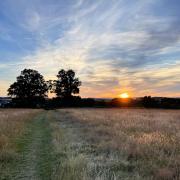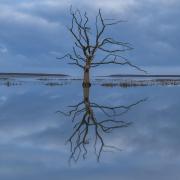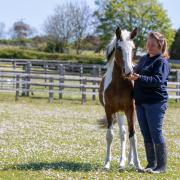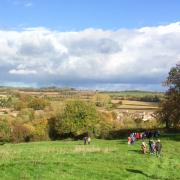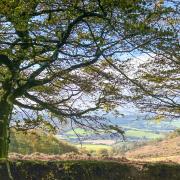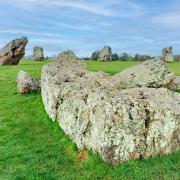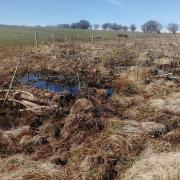Like his father and grandfather before him, John Leach is a household name, and has been fashioning his pots from the Somerset Levels since 1965. Robert Hesketh talks to him about carrying on the family tradition.
Many artists have settled on the...
Like his father and grandfather before him, John Leach is a household name, and has been fashioning his pots from the Somerset Levels since 1965. Robert Hesketh talks to him about carrying on the family tradition.
Many artists have settled on the Levels. Amongst the most celebrated is the world-famous potter John Leach, grandson of Bernard and son of David. "I love the Levels and Moors, indeed all Somerset, which I think has more topographical variety than any other county," says John Leach when I meet him at his pottery just south of Langport.
John lives and works in a thatched cross-passage house in Muchelney on the Somerset Levels. Here he produces a range of distinctive hand-thrown stoneware pots with his colleagues, master potters Nick Rees and Mark Melbourne. As well as the repeat range of kitchen pots - more than 90 designs of everyday tableware, including jugs, casseroles, flagons, mugs and plates - John produces signed, original designs, notably his black pots. Again, these are fired by wood in his three-chambered kiln - fired being the operative word, as flames of up to 60ft lick the pots.
"My pots tell the unadulterated story of fire," says John Leach, "the way flames and ash leave their inimitable mark. I'm not a great decorator like my grandfather, Bernard Leach, but I like the fire doing the decoration."
Firing his pots in a wood-fuelled kiln gives each one a unique finish. Every hand-made pot is subtly different from any that went before or will come after it, but all John Leach's pots are very recognisably his m...tier. Based on the simple strength of English country pottery, they are characteristically sturdy and practical, rounded with glazed interiors, their toasted finish and warm hues are souvenirs from their fiery birth.
"It's very labour-intensive: from striking the first match, a firing takes 36 hours of watching and stoking - every two or three minutes towards the end of the process. Five of us take shifts. We've got a good team; stoking demands a steady rhythm. The draught has to run over the combustible surfaces of the wood."
John always wanted to be a potter, though he also dreamed of being a farmer for a while. As a child, he modelled clay with his father, David, in the pottery established by his grand-father, Bernard Leach. Thus, joining David in his new pottery at Bovey Tracey in Devon seemed the natural thing for John to do when he left school at 18.
John was apprenticed for five years, first to his father, and he then continued his training with Colin Pearson at Aylesford Monastery and with Ray inch at Winchcombe Pottery, Gloucestershire. He completed his apprenticeship with his grandfather at St Ives in Cornwall. Bernard was always frank in his criticism of John's work, but this was helpful and much needed.
"I've never been to art school or university, but the way I was taught is a very good way to learn practical and production skills. I was extremely lucky, too, in learning from very experienced potters who also had the benefits of art school training. The ideal for potters would be to do practical training and then go to art school. Going to art school first puts the cart before the horse."
Altogether, John spent five years learning the potter's craft. After six months' teaching and working in California, he returned to England to work again with his father. In 1964, with a growing family, John and his wife, Lizzie, bought the house at Muchelney, restored it and built the first kiln.
"It was very important to me to have a place that had a good spirit about it, somewhere I felt happy creating," continues John. "After 43 years here we feel almost local!"
"My pots tell the unadulterated story of fire - the way flames and ash leave their inimitable mark"
John's house is deeply rooted in the landscape. Built in the late 16th century with flagstone floors, it contains much older stone salvaged from nearby Muchelney Abbey - some of it Norman. There are some splendid carved stones built into the walls, including one with chevrons and another with a jack in the green.
"It's a wonderful and fulfilling life being an artist craftsman," says John. "We chose to be potters and have the freedom to create our own designs - it's totally different from conveyor-belt production. I particularly like throwing pots - the actual business is so sensual. In fact I love the whole process; creating something useful and different, and making a living at it. It's not a big living in financial terms, but hugely rich in other ways. I feel very grateful and lucky to be doing it. It's always an exciting moment when the kiln is opened and we see, finally, the finished article."
John, Mark and Nick are involved in the entire process of creating a pot. The only thing they do not do themselves is dig the clay and mix it. With a design in mind, they begin by throwing the pot on the wheel. Decoration can be done when the pot is leather-hard. Biscuit firing at 1000°C comes next, followed by glazing, using a mix of feldspar, limestone, quartz and clay mixed with water. John makes four glazes by varying the proportions of these ingredients. The second firing at 1320°C completes production. The finished pots are sold from the adjacent shop and gallery as well as online.
"Firing takes 36 hours of watching and stoking - every two or three minutes towards the end of the process"
John enjoys the challenges posed by creating pottery that must be functional as well as beautiful. Although he finds making practical ceramics gives him plenty of scope for artistic expression, he and his colleagues also make one-off signed pieces that allow them to experiment with shape, colour and design. "We call them our individual work and show them in the gallery."
Airy and well-lit, John's gallery hosts a variety of arts and crafts through the year. "I have catholic tastes in art. I would hate to be confined to a certain school or way of looking at things that pre-empted my eyes from really digesting something new or challenging."
John has travelled widely, organising workshops and giving lectures in Britain and abroad, offering him the opportunity to make fruitful contacts with potters from many craft traditions, European, American and African, but he always returns to Somerset. His favourite place to relax and revitalise is the nine acres of woodland he has planted near his home.
His initial idea was to add his efforts, in a small way, to regenerating Britain's depleted woodlands and compensate for the wood he burns in his kiln, even though this consists of softwood offcuts from a local fencing company. Planting 4,000 mixed hardwood trees, he also dug a one-acre pond, which he describes as "the biggest, best and most important thing I've made in clay." The pond was so successful in attracting dragonflies that it was designated a County Wildlife Site. Crossed with paths, the wood, now a growing canopy, can also be enjoyed by visitors.
John Leach Gallery and Pottery Shop is situated two miles south of Langport. It is open all year, Monday to Saturday, 9am-1pm and 2pm-5pm, (01458 250324. Next exhibition: collagraphs, etchings and linocuts of birds and animals by Julia Manning, 18 November - 11 January. Next Open Day: 29 March, including an exhibition of Henri Matisse prints. Visit www.johnleachpottery.co.uk for online shopping and further details.
WEBSITES:
John Leach www.johnleachpottery.co.uk



